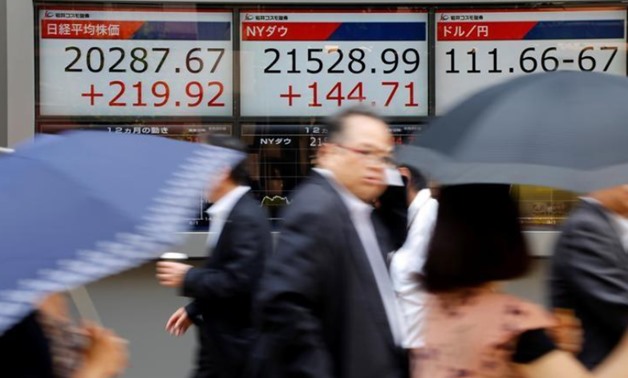
People walk past an electronic board showing Japan's Nikkei average (L), the Dow Jones average (C), and the exchange rates between the Japanese yen and the U.S. dollar outside a brokerage in Tokyo, Japan June 20, 2017 - REUTERS/Toru Hanai
SYDNEY - 19 December 2018: Asian share markets played second string to bonds on Wednesday as a spectacular fall in the price of oil spurred speculation the U.S. Federal Reserve might be done with tightening after its policy meeting later in the session.
Spreadbetters pointed to a muted start for Europe with Estoxx 50 STXEc1 a tad weaker while Dax futures FDXc1 were barely changed. FTSE futures FFIc1 were slightly weaker.
MSCI's broadest index of Asia-Pacific shares outside Japan .MIAPJ0000PUS gained 0.5 percent, while Shanghai blue chips .CSI300 fell over 1 percent.
Japan's Nikkei .N225 slipped 0.6 percent and E-Mini futures for the S&P 500 ESc1 added 0.6 percent.
Oil had stolen the show as a supply glut saw Brent shed almost 6 percent overnight. U.S. crude was last up 20 cents at $46.55 a barrel, while Brent LCOc1 recouped 31 cents to fetch$56.57.
Brent’s 35 percent plunge since October is sending a disinflationary pulse through the world at a time when trade and economic activity are already cooling.
That has only added to pressure on the Fed to abandon its commitment to yet more hikes.
U.S. President Donald Trump on Tuesday warned the central bank not to “make yet another mistake”, while a Wall Street Journal editorial called for a pause.
So far, the futures market <0#FF:> is sticking with a two-in-three chance of a rate increase on Wednesday.
“Despite recent market volatility we think that it is still more likely than not that the Fed will raise rates,” said ANZ senior economist Tom Kenny.
“But we lean slightly toward the Fed removing the reference to the need for ‘further gradual increases’.”
He also expects the median Fed forecast, or dot plots, to drop to two rate rises for next year, from the three projected back in September. The market is well ahead of that and pricing in less than one rise in 2019.
BOND BONANZA
Stocks were left in the dust by bonds as 10-year Treasury yields hit their lowest since August at 2.799 percent US10YT=TWEB, testing a major chart level at 2.80 percent.
Yields on two-year U.S. notes US2YT=TWEB touched a three-month trough of 2.629 percent, a massive turnaround from November’s 2.977 percent peak. Yields in Japan and Australia also reached multi-month lows.
Reasons for the rally were easy to find. The latest survey of fund managers globally from BofA Merrill Lynch showed the third biggest decline in inflation expectations on record, while just over half expected the world economy to slow next year.
Investors rushed into bonds, with the largest ever one-month rotation into fixed-income assets, while cutting equities.
“Investors are close to extreme bearishness,” said Michael Hartnett, chief investment strategist at Bank of America-Merrill Lynch. “All eyes are on the Fed, and a dovish message could equal a bear market bounce.”
The steep drop in Treasury yields undermined one of the U.S. dollar’s major props and pulled its index back to 96.921 .DXY, from a recent top of 97.711.
The dollar fell to 112.39 yen JPY=, from a 113.70 high last week, while the euro nudged up to $1.1383 EUR= from a $1.1266 low.
In commodity markets, gold held near its recent five-month peak as the dollar eased and the threat of higher interest rates waned. Spot gold XAU= was a shade firmer at $1,249.81 per ounce.

Comments
Leave a Comment